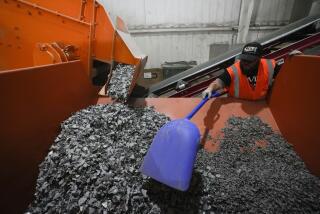Spectrolab May Soar Again With Gallium Technology
- Share via
When the satellite communications industry took off a few years ago, Spectrolab’s business soared with it. The Sylmar-based subsidiary of Hughes Aircraft made the solar cells and panels powering many of the satellites.
But a slowdown in the industry this year, the result of waning interest in direct satellite-to-home broadcasting and a glut of telecommunications satellites, has hit Spectrolab hard.
The company says sales for 1985 are expected to be 27% lower than last year’s $22.5 million, and its work force has dropped from 300 to 200.
The company is betting it can bounce back, however, in part by taking a new tack in manufacturing that will enable it to improve its solar cells and panels. Spectrolab has spent $5.5 million over the past four years on equipment for making a more efficient and durable substitute for silicon used in solar cells, which capture and convert the sun’s rays into electricity.
The silicon substitute, gallium arsenide, is expected to be used on massive--and potentially lucrative--projects such as the National Aeronautics and Space Administration’s space station, scheduled to be in operation in the early 1990s, and in the proposed Strategic Defense Initiative, commonly referred to as “Star Wars.”
“Our goal is the highest performance, most cost-effective and reliable product available,” Larry Spicer, Spectrolab’s president, said of gallium arsenide. “It’s got to be reliable because you don’t want to have to fix it up there.”
Although hundreds of companies are making solar panels to convert energy on Earth, only a handful are making the lighter and smaller units for use in space.
Spectrolab’s biggest domestic competitor is Applied Solar Energy Corp., with 178 employees, based in the City of Industry. Together, Spectrolab and Applied Solar Energy evenly split 95% of the American space solar market, according to Mark Fitzgerald, editor of Photovoltaics International magazine, based in Colorado. Japanese and European manufacturers account for the rest of the market, he said.
Different Production Methods
Both companies are moving into gallium arsenide production. Applied Solar Energy, which also has been hurt by the slowdown, expects to be producing its first cells by early September, several months ahead of Spectrolab.
The two companies have chosen different production methods.
Spectrolab is using what is known as liquid phase epitaxy to manufacture its cells. In this system, gallium arsenide is dissolved in liquid gallium, then slowly cooled to form crystals.
Applied Solar Energy uses metal-organic chemical vapor deposition to grow the crystals, a process that employs gas instead of liquid gallium. That system is capable of higher volume production. William L. Thompson, president of Applied Solar Energy, said his company’s vapor system and earlier start will enable it to gain more of the market.
Spicer counters that the vapor process, although the next generation for the industry, isn’t ready yet. Spectrolab plans to move into a similar vapor process by early 1987, Spicer said.
Both companies look to defense contractors for their work. Spectrolab, as a Hughes subsidiary, has an instant advantage with its contracts, Applied Solar officials say. But Applied Solar Energy has an agreement to get regular business from RCA.
Fighting for Contracts
Spectrolab and Applied Solar Energy fight for contracts from Lockheed and TRW, among others, said Ken Ling, Applied Solar Energy’s vice president for research and development. About 40% of Spectrolab’s contracts are for branches of the federal government, including NASA and the Defense Department, through prime contractors. Applied Solar Energy has a special relationship with the Air Force, which put up $3.5 million in 1982 to get the company started on gallium arsenide research and development.
The NASA space station, a project expected to go to one or both of the companies, will be the biggest satellite ever built, operating on 200 kilowatts, or 200,000 watts, of power. A typical communications satellite uses only 1,000 watts. Even the giant Skylab used only 21 kilowatts.
The space station, therefore, will need as many chips as are now used in 200 satellites, and the project is expected to bring Spectrolab $10 million to $25 million.
Since it was formed in 1959, Spectrolab has made solar cells and panels for 350 satellites.
At the Sylmar manufacturing plant there is a series of “clean rooms,” all spanking white, where workers wear white smocks, and head and shoe coverings made of paper to keep impurities from affecting the process.
Shiny Rectangles
Solar chips are shiny rectangles with tiny, intricate grid patterns. Most are 2 inches by 4 inches, although different engineering requirements for satellites mean chips can be of varying sizes. The chips are bonded to panels at Spectrolab.
One panel in a main assembly room is 20 feet long by 9 feet wide, and curved to allow it to fit in the cargo bay of the space shuttle, from which satellites are launched.
Officials of Spectrolab and Applied Solar say their business has suffered because fewer satellites are going up than was expected several years ago. They attribute the trend to two factors: lagging interest in home-entertainment systems using satellite signals and dishes and a reduction in launchings.
Soft Market
Because of the soft market, Spectrolab is not banking only on gallium arsenide. The market is too vulnerable, Spicer said. For example, the United States only sends up 10 to 20 satellites a year, and companies such as Spectrolab and Applied Solar can be hurt by even modest cutbacks in such a small business.
Spectrolab has diversified into selling solar simulators that produce artificial sunlight for testing solar equipment. The company also makes searchlights used mainly for police and military helicopters.
The lights, together with the simulators, make up about 20% of Spectrolab’s sales, Spicer said. Spectrolab is looking for a third line of business for further diversification, he said.
“The satellite market is as cyclical as the housing market,” Spicer said. “We need to get into other compatible businesses.”
More to Read
Inside the business of entertainment
The Wide Shot brings you news, analysis and insights on everything from streaming wars to production — and what it all means for the future.
You may occasionally receive promotional content from the Los Angeles Times.










